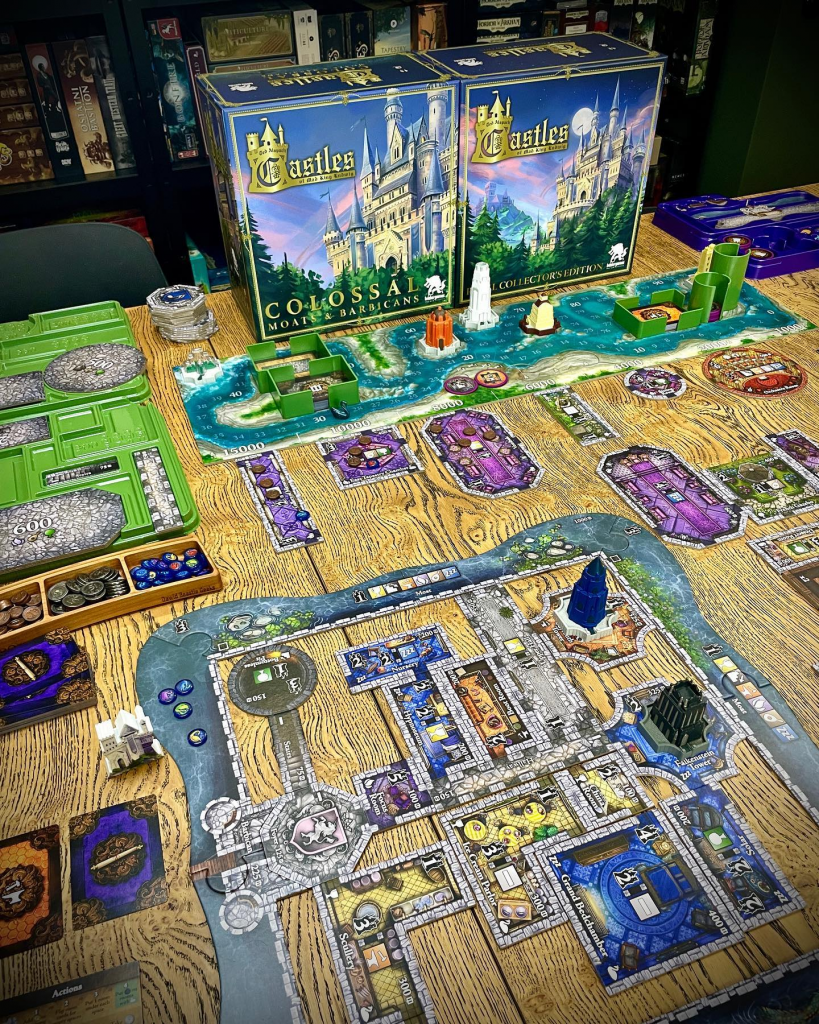Every year, I prepare a top 100 board game list around this time. I like to do it at this time so that both of y’all that go on and read this content might use it to inform your Christmas shopping. The side effect of all this is that I’ve managed to add a time-intensive and stressful project with a relatively hard deadline on top of all of the other looniness that is the Christmas season. It is very possible I am a masochist.
As with the last couple of years, I have used PubMeeple‘s ranking engine to do the bulk of the sorting. If y’all think my list is ass, that’s fine, go and make your own!
100. Castles of Mad King Ludwig – Collector’s (Colossal) Edition
“Satisfy the king’s whims by building the best fantasy castle, now with more options.”
Released: 2022
Designer: Ted Alspach
Players: 1-5
Estimated Time: 60-90
Last Year: 83

Castles is inspired by a real life king, King Ludwig II of Bavaria, who (depending on who you ask) lavishly spent to build a series of increasingly ridiculous castles. Players, serving as architects, will draft rooms and try to assemble them in ways that completes certain mission goals. The result is that each player will finish the game with a uniquely wierd and wonderful castle. Why, exactly, is the Love Grotto attached to the Butter Room? Why, indeed.
This is a very good game that manages to cling to the bottom of the list because of the Colossal Edition of the game, which is… stupid big. Each piece in this edition is twice as large as in the original, which results in wonderfully large castles and also a gaming experience where three people can BARELY fit a game on a large dining room table. Still, if you’re looking for a ridiculously awesome – albeit pricey – table presence, here you go.
99. Unsettled
“A cooperative survival game in the bizarre and wondrous reaches of deep space.”
Released: 2021
Designer: Tom Mattson, Mark Neidlinger
Players: 2-4
Estimated Time: 60-90
Last Year: 54

In Unsettled, players crash land onto an alien planet, where they must work together in order to find their way off. The mechanics are relatively simple – players can explore and scan, mostly, to find what they need to get off that rock – but the physics of each planet is different, and therefore the puzzle on each planet you find yourself on is completely different. Left relatively unsaid is that it’s pretty weird how your crew keeps crashing into planets.
One thing that really stands out in Unsettled is the writing. Normally, writing in board games is either very dry or very generic. Unsettled is… funny – unafraid to be cheeky and even point out the core absurdities of the game’s central premise. Which is important — a mission-based scenario system works so much better if players are eagerly looking forward to unlocking the next story nugget in the narrative.
98. On Tour
“Plan the best tour route for your band across the USA or Europe.”
Released: 2019
Designer: Chad DeShon
Players: 1-8
Estimated Time: 20 minutes
Last Year: 79

A simple ‘draw and write’ game where you take numbers that are drawn and place them on a map of the US. While trying to accomplish other placement goals for those numbers, at the end of the game, each player will draw a route for their band’s tour bus, where all numbers on their planned route are in ascending order. The best route wins.
The “… and write” genre was huge just a couple of years ago, and as such I considered more than a dozen when making this list. The allure of ‘… and writes’ has fallen quite a bit, though. This is the only pure ‘… and write’ to make the list. Hadrian’s Wall came close, but frankly is too heavy a game to scratch the filler game itch that you want from a roll and write experience.
97. Yedo
“Clans scheme and plan to complete missions in the city of Yedo.”
Released: 2012
Designer: Thomas Vande Ginste, Wolfe Planke
Players: 2-5
Estimated Time: 120-180 minutes
Last Year: 59

The general flow of Yedo will seem familiar to anyone who likes Lords of Waterdeep – you are the lord of a mighty clan in imperial Japan, and you complete quests by assembling all the quest requirements, which are mostly acquired by sending off your ninja workers to get what you need. There are some spicy design twists as well, such as a wandering watchman who will shut off worker placement options. There are also a wide slew of action cards, divided into categories. This allows you to tailor the experience to be more or less aggressive and/or ‘take that’.
Yedo has stubbornly been on my list a long time. It’s a gorgeous game that is simple to teach and is easy to dial up the complexity if you want a longer or more complex and interactive game. That said, part of my fandom is that I got my hands on the Deluxe Master Set, which takes the production values of the whole experience to eleven.
96: Epic Spell Wars of the Battle Wizards: Annihilageddon 2 Extreme Nacho Legends
“The Battle Wizards are back in the most RADICALLY sorcery-slinging sequel ever! “
Released: 2022
Designer: Cory Jones, Erik V Larsen, Ben Stoll
Players: 2-5
Estimated Time: 45-60 Minutes
New to List

Epic Spell Wars is a fairly basic deckbuilder, where players draw from a shared deck and assemble their own deck of cards to try to go to war with other players. Fans of Dominion will surely see the similarity, although there are some key differences. Epic Spell Wars is about direct warfare and attacking each other, for starters. Also it’s full of…. penis jokes.
Epic Spell Wars is not for everyone. To truly enjoy this, you need to be able to have, at least temporarily, the sense of humor of an 11-year-old boy. As an example, the ‘curse’ effect in the game is a ‘limp wand’. Get it? Heheheheheheheh. Still, if you can lower your mindset to this level, it’s very silly fun, and also for some reason the primary currency of the game you can get a nacho chip tokens.
And yes, that giant obnoxious trophy in the picture is a prop from the game.
95. Maglev Metro
“Efficiency is the key to rebuilding the city transit with maglev tech. “
Released: 2021
Designer: Ted Alspech
Players: 1-4 Players
Estimated Time: 60-90 Minutes
Last Year: 60

In this game, players will work together to try to build a subway system. Each player plays as a subway line, and are given a bunch of translucent hexes with subway routes of one color. Each player will try to build their own unique lines to try to complete personal objectives as well as try to guide passengers home to their destination.
Maglev Metro‘s strength is its unique board presence and the tactile feel of the plastic pieces – there are tons of train games, but none that use this aesthetic, which ends up being a pretty damn good representation of a modern subway map. It’s a good and interesting puzzle, and the Maglev Maps expansion, which is a tad on the pricey side, still manages to add new twists in interesting ways.
94. Nothing Personal
“Blackmail. Bribery. Crime. Negotiations abound-but only one can be the next mob boss.”
Released: 2013
Designer: Stephen Avery, Tom Vasel
Players: 3-5
Estimated Time: 120 Minutes
No Ranking Last Year (appeared in previous lists)

In this game, players control a mob family, and each player is attempting to manipulate their way up a social heirarchy so they can be the mob boss. Along the way, their goons will encounter a wide variety of roles, which can impact their odds, but the brunt of the game is political – players wheeling and dealing with each other to manipulate their way into position.
Nothing Personal is the best – and I believe most recent – game in what I call the ‘social heirarchy’ game, a genre pioneered by the classic Kremlin and improved upon by the roman fowl game Chicken Caesar. These games have created some of the best pure social gameplay I’ve ever seen, but in the decade since Nothing Personal came out, the entire social genre has really shifted over to lighter social deduction games like Coup, Ultimate Werewolf and The Resistance. Which is fine, I guess, but all of those really require larger groups and aren’t really my jam.
93. Blood Rage
“Ragnarök has come! Secure your place in Valhalla in epic Viking battles.”
Released: 2015
Designer: Eric M. Lang
Players: 2-4 Players
Estimated Time: 60-90 minutes
Last Year: 27

Blood Rage is a fine mix of deckbuilding and area control, as players jockey to win battles on a game board that is crumbling beneath their feet. It’s simultaneously a meaty and satisfying experience while somehow also being fast, streamlined and well-balanced. The presentation is beautiful and the miniatures are wonderful.
Blood Rage is on the top 10 lists of just a ton of the sort of people who make lists, nearly a decade after its initial release. Many consider it to be the best game that Eric Lang has ever done, but we’ll see him again on this list a couple of times. In fact, one of those times is very, very soon.
92. Las Vegas/Las Vegas Royale
“Win the payout from various casinos by placing the most dice on them. “
Released: 2012
Designer: Rudiger Dorn
Players: 2-5
Estimated Time: 30
No Ranking Last Year (Appeared on Previous Lists)

Las Vegas is a simple enough game that you don’t even need to buy the game, you just need a handful of dice and paper money. Players roll dice, and then choose all of the dice with the same number and place them on a single casino with a matching number. At the end of the round, whoever has the most dice on a casino claims that casino’s money, but if two people are tied, they are ignored and the money goes to the third place finisher.
Las Vegas is just an ideal filler game – incredibly fast to teach, incredibly easy to play, incredibly quick to finish. It’s highly interactive with a lot of asshattery and yet the games are fast enough you don’t care. The premium edition (Las Vegas Royale) is good, too. It increases the production values nicely. It does also add some additional complexity to the game which, frankly, is okay but unnecessary. If you slap Las Vegas on the table, you’re probably doing it because you want the simplicity of the core experience.
91. Marvel United
“Cooperate as Marvel Heroes to stop the Villains’ master plans! “
Released: 2020
Designer: Andrea Chiarvesio, Eric M. Lang
Players: 1-4
Estimated Time: 40 minutes
Last Year: 90

I told you we’d see Eric Lang again! Marvel United is a simple card-based coop experience, where each player plays a single hero with a simple and unique 12-card deck of cards. They’ll try to use a simple set of actions to defeat the villain’s plan.
I originally bought all of Marvel United because the chibi-style Marvel miniatures seemed ideal to improve my miniature painting skills, but was ultimately impressed at the surprising depth in this simple game. The hero abilities aren’t as unique as perhaps they should be, but the villians are – each villian is a fundamentally different puzzle for players to solve and it’s truly impressive how this simple ruleset was stretched – and continues to stretch.
If you decide to get into Marvel United, you don’t need all of it, but do focus on finding the boxes that have villains. There’s more coming, soon – in 2024, they’ll be releasing basically ‘what if’ variants of their heroes in a Multiverse-themed kickstarter expansion event. And while I don’t know why, I do know that Spidergeddon (their Spiderverse-themed expansion) is getting rave reviews from those able to get a play of it at their local game conventions.





































































































Recent Comments